|
|
|
Sort Order |
|
|
|
Items / Page
|
|
|
|
|
|
|
| Srl | Item |
| 1 |
ID:
096703
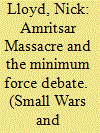

|
|
|
|
|
| Publication |
2010.
|
| Summary/Abstract |
This article re-examines one of the most infamous incidents in British imperial history: the Amritsar Massacre of 1919, and analyses it within the context of the British Army's minimum force philosophy. The massacre has long been regarded as the most catastrophic failure of minimum force in the history of the British Army. This article reconsiders the arguments over the shooting at Amritsar and the role of Brigadier-General Reginald Dyer, and questions the accepted view that the massacre was such a failure of minimum force. It argues that the circumstances surrounding the massacre must be understood before judging the incident and given these factors it is possible to see it within a minimum force framework.
|
|
|
|
|
|
|
|
|
|
|
|
|
|
|
|
| 2 |
ID:
116260
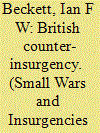

|
|
|
|
|
| Publication |
2012.
|
| Summary/Abstract |
The article aims to offer a survey of the historiographical analysis of British counter-insurgency practices and campaigns since the publication of Armed Forces and Modern Counter-insurgency, edited by the author and the late John Pimlott in 1985. It is argued that the volume in question was influential at a time when there was little academic interest in counter-insurgency in Britain. Moreover, the subject generally had been little studied in Britain in the past beyond work by a handful of military writers and theorists. Arguably, the analytical framework followed in Armed Forces and Modern Counter-insurgency holds its value even after over a quarter of a century. Since the 1980s, however, it has become apparent that the subject is of increasing academic interest, not least in terms of the ongoing debate on the nature and application of the concept of 'minimum force' in British campaigns.
|
|
|
|
|
|
|
|
|
|
|
|
|
|
|
|
| 3 |
ID:
116250
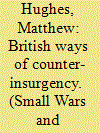

|
|
|
|
|
| Publication |
2012.
|
| Summary/Abstract |
This essay introduces the special issue, drawing together the different studies around the central theme of the nature of the force used by Britain against colonial insurgents. It argues that the violence employed by British security forces in counter-insurgency to maintain imperial rule is best seen from a maximal perspective, contra traditional arguments that the British used minimum force to defeat colonial rebellions. It shows that the use of force became more difficult especially after the Amritsar massacre in 1919. The presence of white settlers in counter-insurgencies - such as in Kenya in the 1950s - accelerated abuse by security forces and complicated the measured use of force against insurgents by the colonial state. The article concludes by drawing lessons from the British experience of counter-insurgency to unconventional military operations today, suggesting that in some situations the use of maximal force is still an option in counter-insurgency.
|
|
|
|
|
|
|
|
|
|
|
|
|
|
|
|
| 4 |
ID:
165199
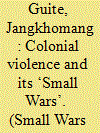

|
|
|
|
|
| Summary/Abstract |
This paper concerns the lesser known British counterinsurgency (COIN) operations in Northeast frontier of India during the First World War. Officially known as the ‘Kuki Operations’, it was considered as part of the Great War. Carried out in isolation from press and public, and shelved in colonial archives, the event remained invisible until today. Yet, it registers a critical case of colonial COIN doctrine where the ‘moral effect’ doctrine was employed without being questioned. It unleashed enormous amount of organized violence, ranging from shoot at sight to indiscriminate burning of villages, wholesale destruction of property and livestock, prevention of cultivation and rebuilding of villages, forced mass displacement in jungles or in ‘concentration camps’, and collective punishment (communal penal labour and payment of compensation) after the war. This paper argues that the theory of ‘minimum force’ and the practicability of the ‘moral effect’ doctrine as applied by the Empire, sit oddly with each other at the frontier, where violence was seen both as a natural and moral orders. Violence as an ‘imperatively necessary’ method to bring order in a disorderly frontier, in the opinion of colonial state, informs and registers Northeast India as geography of violence.
|
|
|
|
|
|
|
|
|
|
|
|
|
|
|
|
| 5 |
ID:
083036
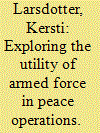

|
|
|
|
|
| Publication |
2008.
|
| Summary/Abstract |
The robust approach of the American forces in for example Afghanistan and Iraq is often criticised and compared to the more soft approach of the British forces. However, there are surprisingly few systematic studies on the relationship between the conduct of force and the outcome of peace operations. Two kinds of military conduct in Afghanistan have been explored in this article, one that could be called 'minimum force' and one that could be called 'show of force'. Contradicting the commonly held idea of the superiority of 'minimum force', 'show of force' correlated with a better outcome than the 'minimum force' approach. However, before arguing that a 'show of force' approach is a better way to conduct peace operations, more reliable data on the outcome, and additional case studies, are needed.
|
|
|
|
|
|
|
|
|
|
|
|
|
|
|
|
| 6 |
ID:
099857


|
|
|
|
|
| Publication |
2010.
|
| Summary/Abstract |
With strategic success in Iraq and Afghanistan far from certain, comforting beliefs about Britain's superiority at counterinsurgency have come under increasingly sceptical scrutiny. This article contributes to the debate with particular reference to the supposedly pivotal principle of minimum force. After discussing the recent literature on the subject, the article critiques the methodology employed by advocates of the traditionalist view on British COIN, arguing for a more rigorous historical approach based on primary sources. Following these historical matters, it is argued that conceptually, minimum force should be analysed dialectically in relation to practices of exemplary force, and above all, on the evidence of what happens in a conflict. Arguably the value ascribed to doctrine in strategic analysis has become unduly inflated, and we must look beyond it to understand war and political violence.
|
|
|
|
|
|
|
|
|
|
|
|
|
|
|
|
| 7 |
ID:
144331
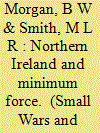

|
|
|
|
|
| Summary/Abstract |
The debate over whether there exists a British counter-insurgency tradition of minimum force is one that has been thoroughly discussed. Is there anything left to say? This study suggests there is further insight to be attained if one explicitly evaluates the concept of minimum force in relation to the conduct of the security forces in the years of the Northern Ireland conflict. Through an examination of three key periods in the conflict, it will be shown that while there was invariably an awareness of the need to act with restraint among senior officers at the strategic level, this was often difficult to apply at the tactical level in the heat of confrontation. The argument demonstrates that the British Army, and other instruments of the state, rarely acted in a manner that could be described as ‘minimal’. Instead, it was the broader liberal values of the British state that explains largely the degrees of restraint exhibited by the government and security forces.
|
|
|
|
|
|
|
|
|
|
|
|
|
|
|
|
| 8 |
ID:
122221
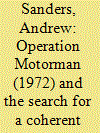

|
|
|
|
|
| Publication |
2013.
|
| Summary/Abstract |
The role of the British Army in Northern Ireland during Operation Banner (1969-2007) is an instructive case study of counterinsurgency operations as well as an important chapter in recent British military history. Given troops deployed to the province as aid to the civil power, it is particularly useful in discussions about the principle of minimum force. This article seeks to explore the issue of minimum force through the example of Operation Motorman, the Army's successful attempt to remove the barricades, which had established so-go areas for the security forces in Northern Ireland.
|
|
|
|
|
|
|
|
|
|
|
|
|
|
|
|
| 9 |
ID:
092308
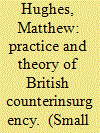

|
|
|
|
|
| Publication |
2009.
|
| Summary/Abstract |
This article details two largely unreported atrocities by British forces operating against Arab rebels during the Arab revolt, 1936-9, at the Palestinian villages of al-Bassa and Halhul. It then examines the military-legal system that underpinned and authorised British military forces operating in aid of the civil power, suggesting that the law in place at the time allowed for a level of reprisals and punitive actions, such as happened at al-Bassa and Halhul. The article does not conclude that the law allowed for atrocities but it does argue that it gave a basic form and understanding to an operational method that was brutal and could lead to atrocities. It thus tests the idea in much of the literature on counterinsurgency that the British were restrained and used minimum force when compared to other colonial and neo-colonial powers fighting insurgents.
|
|
|
|
|
|
|
|
|
|
|
|
|
|
|
|
| 10 |
ID:
160027
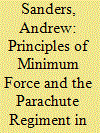

|
|
|
|
|
| Summary/Abstract |
Developing literature on Operation Banner, the codename for the British military operation in Northern Ireland, has indicated that the conduct of soldiers deployed was not always in line with principles of minimum force. Adherence to these principles would seem to have been essential to the success of the operation given the initial deployment of the soldiers was in the role of military aid to the civil power. This article will examine the role of one of the British Army’s most aggressive units, the Parachute Regiment, and will show how the responses of the regiment to the demands of the operation in Northern Ireland were frequently in contravention of minimum force principles.
|
|
|
|
|
|
|
|
|
|
|
|
|
|
|
|
| 11 |
ID:
139107
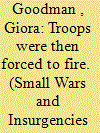

|
|
|
|
|
| Summary/Abstract |
In November 1945, British army shooting during street riots and search operations in Palestine resulted in the death of 13 Jews and the injuring of dozens. The most costly in casualties caused by army fire during the whole Jewish insurgency, these incidents have nevertheless not received detailed attention in literature on the British army's counterinsurgency campaign in postwar Palestine. This article outlines British military use of firepower to control civilian crowds and the difficulties involved during these incidents, contributing to the debate on the army's principal of ‘minimum force’. It also highlights the serious problem of legitimizing opening of fire on unarmed protestors, epitomized in the army's fabricated account justifying shooting at a large crowd rushing a military cordon at Givat Hayim.
|
|
|
|
|
|
|
|
|
|
|
|
|
|
|
|
|
|
|
|
|